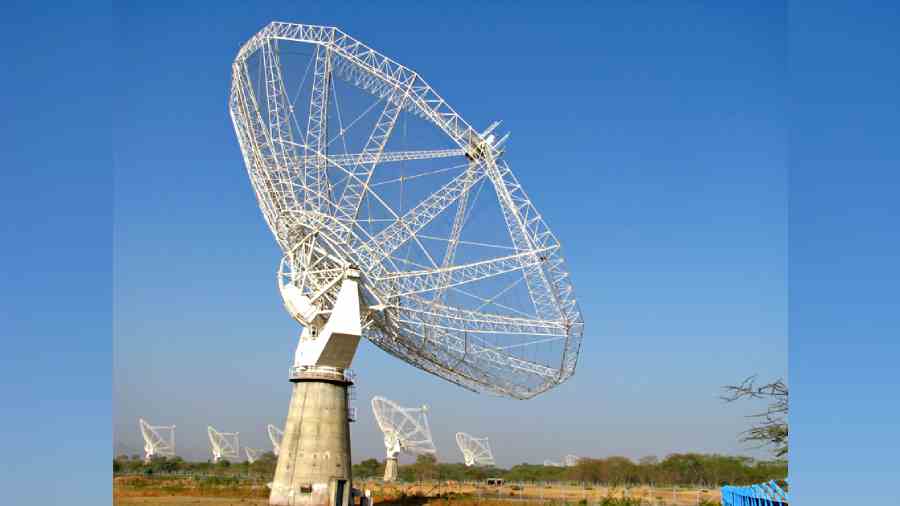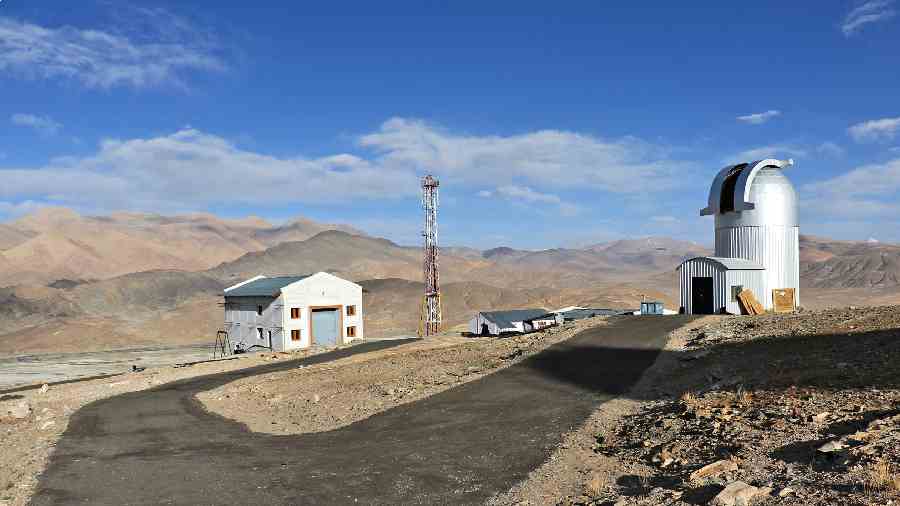In a distant galaxy some 8.5 billion years ago, a supermassive black hole began to tear apart and gobble up a star, triggering a burst of energy and light from the star’s death throes. At dawn on February 14 this year, Harsh Kumar, a research scholar at the Indian Institute of Technology, Bombay, ordered a robotic telescope in Ladakh, to observe the bright flash from that event detected three days earlier by scientists at the Palomar Observatory in southern California, US.
The Ladakh telescope, established four years ago by the Indian Institute of Astrophysics, Bangalore, and IIT, Bombay, is part of a Global Relay of Observatories Watching Transients Happen (GROWTH) aimed at studying so-called transients. These are sudden flashes in the sky typically caused by supernovae, the explosive end-stage of stars, or by novae or cataclysmic variable stars, processes that cause an abrupt and dramatic increase in the brightness of stars.
Within hours of observing the event, Kumar and his supervisor Varun Bhalerao sensed something was unusual. “What we saw in this event didn’t match typical signatures of supernovae, novae, or other most likely candidate sources of transients,” said Bhalerao, an astrophysicist and associate professor at IIT Bombay.
The GROWTH-India team informed the international collaboration, setting off weeks of intense scrutiny of the event by dozens of astronomers worldwide using over 20 telescopes, including India’s space-based Astrosat. Those observations revealed extreme energies and brightness change patterns that were hallmarks of a tidal disruption event (TDE) — the burst of energy and light released when a star is torn apart by the intense gravity of a supermassive black hole.
“The GROWTH-India data told us the source was special,” said Igor Andreoni, an astronomer at the University of Maryland, US, and a member of the GROWTH network.
The TDE was the brightest yet detected and the most distant — halfway across the universe. “For the first time, we’ve had a chance to observe an early extreme phase of such an event,” Dheeraj Pasham, a scientist at the Massachusetts Institute of Technology, US, told KnowHow.
Matt Nicholl, an astronomer at the University of Birmingham in the UK, said the collective observations had provided “new insights” and helped “understand better how black holes consume matter”.

The Ladakh telescope (top), set up by the Indian Institute of Astrophysics, Bangalore, and IIT, Bombay; (above) the Giant Metrewave Radio Telescope at Pune
India’s Giant Metrewave Radio Telescope (GMRT), an array of 30 dish antennas set up in Khodad near Pune, is set to help an international search for extremely weak and elusive gravitational waves. A consortium of Indian researchers released last month’s data, which they say will be critical in a global effort to look for these ultra-low frequency gravitational waves believed to permeate all space-time but not observed yet.
Albert Einstein had predicted gravitational waves in his general theory of relativity. And scientists first spotted gravitational waves in 2015 using sophisticated laser-based giant detectors in the US. Since then, physicists have documented over 90 gravitational wave signals — all produced during collisions of pairs of stellar-mass black holes or dead stars and all of them high-frequency gravitational waves that last only fractions of seconds.
But theoretical calculations predict that collisions of supermassive black holes tens of millions of times more massive than the sun will generate ultra-low frequency gravitational waves that are weak but last longer than the stronger high-frequency waves detected so far.
“What we’ve detected so far are like crescendos or the loudest points in a symphony. We’re now looking for the base sounds or the softer but longer-lasting notes in the symphony,” said Pratik Tarafdar, a scientist at the Institute of Mathematical Sciences, Chennai.
“The calculations suggest that these ultra-low frequency gravitational waves could last for months to decades as the supermassive black holes approach each other,” said Prerna Rana, an astrophysicist at the Tata Institute of Fundamental Research, Mumbai.
Rana and Tarafdar are part of a 40-member consortium of Indian and Japanese researchers that used the GMRT to record pulselike signals from so-called millisecond pulsars — dead stars rotating at high speeds, emitting signals with each rotation.
The millisecond pulsar data from the GMRT will go into the International Pulsar Timing Array, a global effort involving researchers in Australia, Europe and the US. They are accumulating the pulsar signals to look for tiny perturbations that could be caused by ultralow frequency gravitational waves.
The GMRT data is based on unique radio frequencies that help scientists filter out the noise or the distortions in the pulsar data caused by electrons in the interstellar space between the pulsars and the earth.
Faint signals picked up by another radio telescope called SARAS in northern Karnataka have helped astronomers from Australia, India, Israel and the UK to determine the rate of star formation in galaxies only 200 million years after the Big Bang, or the birth of the Universe, 13.8 billion years ago.
The signals representing energy emissions from hydrogen atoms in the earliest, oldest galaxies suggest that less than three per cent of hydrogen gas was being converted into stars, or roughly the same rate of hydrogen-to-star formation at present.
“This is the first time ever we’ve been able to measure the properties of galaxies so old,” said Saurabh Singh, associate professor at the Raman Research Institute, Bangalore, which established SARAS in 2020. “Our observations suggest the earliest galaxies that were bright in radio emissions were also strong in X-rays which heated the cosmic gas in and around the early galaxies.” An astronomer and team member at the UK’s University of Cambridge, Anastasia Fialkov, said observations with SARAS have helped impose “limits on the masses of the earliest galaxies and on the efficiency with which these galaxies can form stars”.











